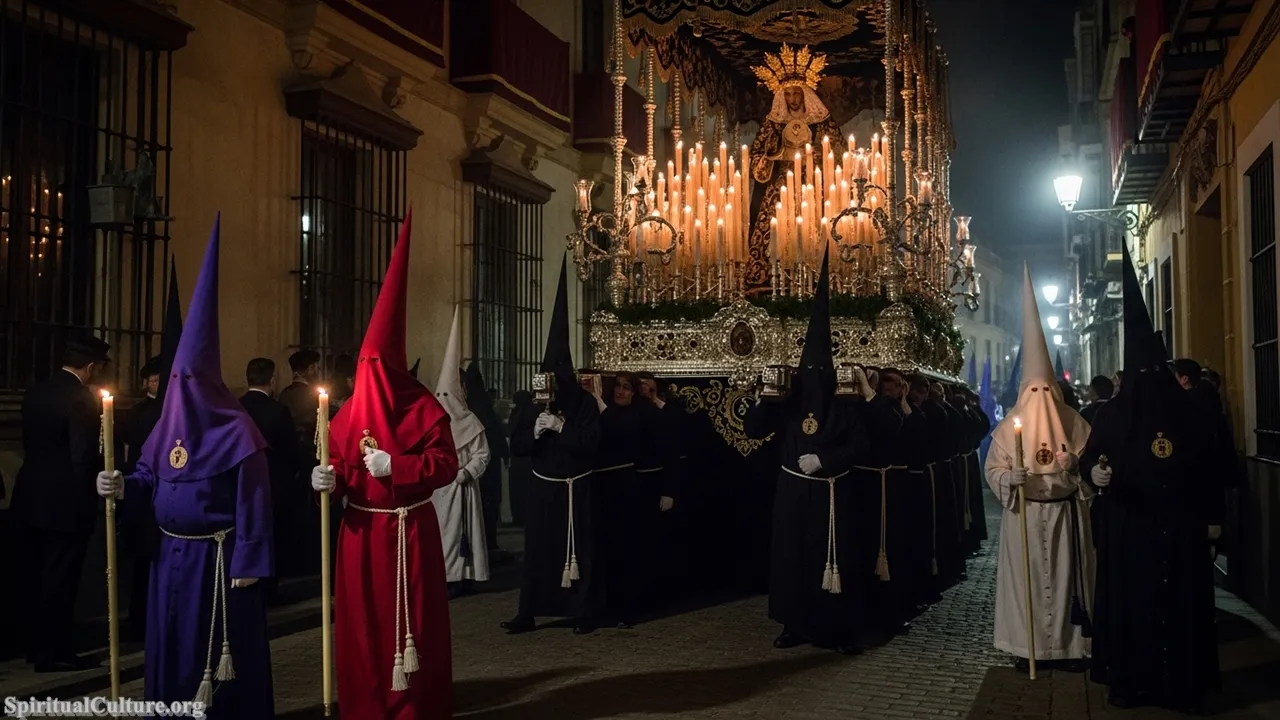The continent of Europe is not merely a geographic entity; it is a repository of human history, a living textbook where every cobblestone and column narrates a saga of innovation, faith, conflict, and artistic revolution. From the cradles of democracy in the Mediterranean to the spiritual heartlands of monotheism, its historical sites are the physical anchors of global civilization.
At Spiritual Culture, we believe the true value of heritage is measured by its enduring influence on human thought and spirit. Therefore, this guide moves beyond mere architectural grandeur to rank the sites that fundamentally shaped philosophy, religion, political systems, and the collective soul of the West.
As of the Current Time of Writing, these locations continue to inspire millions, serving as powerful reminders of humanity’s past triumphs and profound spiritual quests. They are cultural touchstones, meticulously preserved and universally recognized for their capacity to connect contemporary life to the deep streams of antiquity and sacred belief. Our ranking criteria prioritize the spiritual impact, historical-cultural significance, and universal heritage recognition of these monuments.
Table of the Top 10 Most Important Historical Sites in Europe (Cultural & Spiritual Significance)
| Rank | Site Name | Location | Era/Key Cultural Period | Spiritual/Cultural Influence | UNESCO Status |
|---|---|---|---|---|---|
| 1 | Vatican City (St. Peter’s Basilica & Sistine Chapel) | Rome, Italy (City-State) | 4th Century AD – Present | Global Center of Catholicism; Renaissance Art/Theology | World Heritage Site |
| 2 | The Acropolis of Athens (Parthenon) | Athens, Greece | 5th Century BC (Golden Age) | Birthplace of Democracy, Western Philosophy, and Classical Art | World Heritage Site |
| 3 | Stonehenge | Wiltshire, UK | c. 3000 BC – 2000 BC (Neolithic/Bronze Age) | Prehistoric Sacred Site; Megalithic Engineering; Solar Alignment | World Heritage Site |
| 4 | Historic Centre of Rome (Colosseum, Forum, Pantheon) | Rome, Italy | Ancient Roman Empire (Republic to Empire) | Origin of Western Law, Governance, Architecture, and Imperial Power | World Heritage Site |
| 5 | Santiago de Compostela (Pilgrimage Route & Cathedral) | Galicia, Spain | 9th Century AD – Present | End point of the Camino de Santiago; Major Christian Pilgrimage Site | World Heritage Site (The Route) |
| 6 | The Alhambra, Generalife and Albayzín | Granada, Spain | 13th – 15th Centuries (Nasrid Dynasty) | Pinnacle of Moorish/Islamic Art and Architecture in Europe | World Heritage Site |
| 7 | Assisi, Basilica of San Francesco | Umbria, Italy | Medieval (13th Century AD) | Birthplace of St. Francis; Center of Franciscan Spirituality and Poverty | World Heritage Site |
| 8 | Auschwitz-Birkenau | Oświęcim, Poland | 1940 – 1945 (WWII) | Holocaust Memorial; Symbol of Human Suffering and Moral Conscience | World Heritage Site |
| 9 | Notre-Dame Cathedral, Paris | Paris, France | 12th – 14th Centuries (Gothic Period) | Masterpiece of Gothic Architecture; Cultural and Religious Heart of France | World Heritage Site |
| 10 | Meteora Monasteries | Thessaly, Greece | 14th Century AD | Eastern Orthodox Monasticism; A Fusion of Nature and Spiritual Ascent | World Heritage Site (Mixed Site) |
Top 10 Most Important Historical Sites in Europe
Top 10. Meteora Monasteries, Greece
Perched atop colossal natural sandstone pillars, the Meteora Monasteries in Thessaly, Greece, represent a breathtaking attempt by humankind to seek divine closeness through physical elevation. Dating primarily to the 14th century, these monasteries were built by Eastern Orthodox monks seeking a spiritual retreat from political turmoil, demonstrating extreme dedication and architectural ingenuity. They remain functional today, offering a rare glimpse into a contemplative life tradition.

Their spiritual impact lies in the literal and figurative ascent toward heaven. The act of building a community high above the earth symbolizes the spiritual journey—leaving the material world below to focus on the transcendent. For centuries, the monks here have preserved Byzantine art, manuscripts, and spiritual traditions, making Meteora a crucial living repository of Eastern Orthodox culture and a powerful symbol of spiritual resilience.
The lesson of Meteora is one of profound commitment and the sacred power of place. It teaches us that true spiritual practice often requires deliberate separation and monumental effort. The monasteries compel visitors to reflect on the immense effort required to bridge the gap between the mundane and the divine, emphasizing the role of nature as a catalyst for spiritual awakening and the importance of preserving ancient monastic lifestyles.
Cultural/Spiritual Highlights
- UNESCO Mixed Site (Culture and Nature) since 1988.
- Means “suspended in the air,” symbolizing the isolation of monastic life.
- Preserves vital frescoes, icons, and artifacts of the Byzantine post-Imperial era.
- Currently, six of the original twenty-four monasteries are still inhabited and functioning.
Top 9. Notre-Dame Cathedral, Paris
Standing on the Île de la Cité in Paris, Notre-Dame is arguably the most famous example of French Gothic architecture. Begun in 1163, it was a central cultural and religious pillar for over eight centuries, witnessing coronations, state funerals, and the daily rhythm of Parisian life until the devastating fire of 2019. Its ongoing reconstruction, a global endeavor as of the Current Time of Writing, highlights its irreplaceable cultural standing.
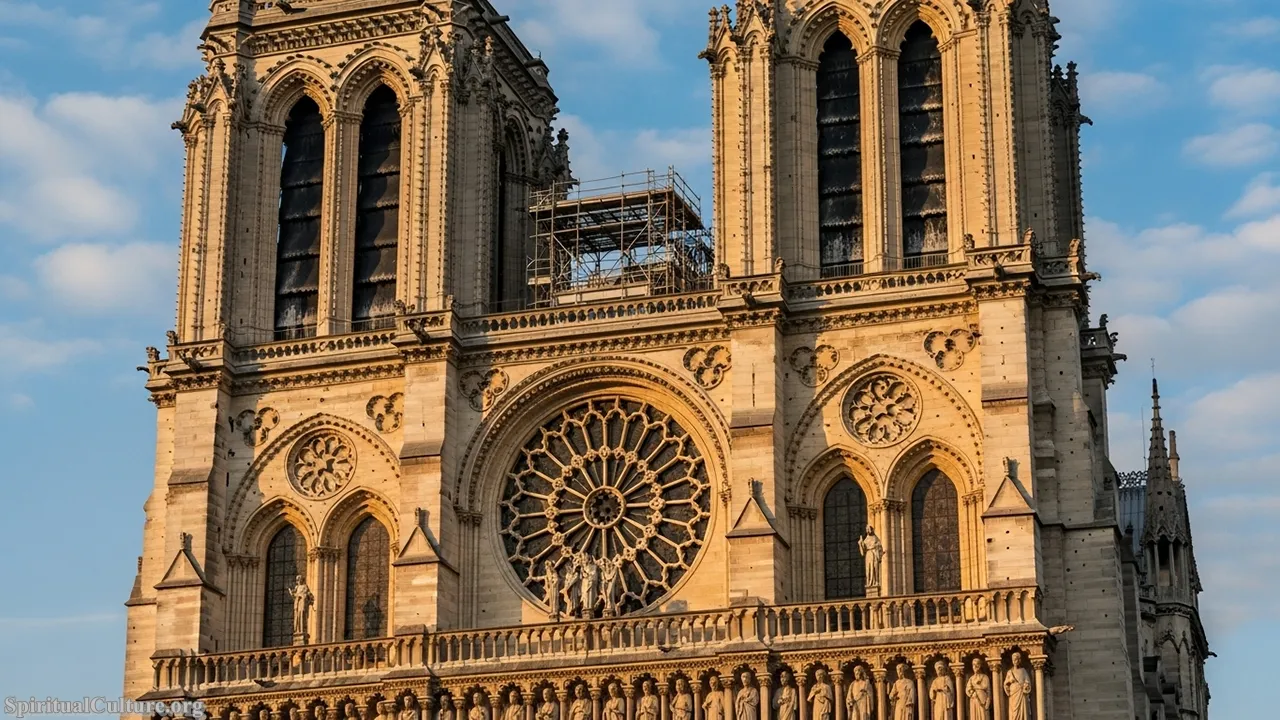
The spiritual impact of Notre-Dame is found in its magnificent architectural scale, designed to inspire awe and devotion. The soaring, vaulted ceilings and the intricate rose windows create a ‘heaven on earth,’ symbolizing the majesty of the divine in physical form. As the focal point of the French Church and host to the Crown of Thorns relic, it has been a profound site of pilgrimage, devotion, and national spiritual identity for nearly a millennium, linking the fate of France to its Catholic heritage.
The cathedral’s survival through revolution, war, and fire teaches a powerful lesson about the endurance of human spirit and the resilience of faith. Its current resurrection, driven by worldwide commitment, reflects a profound collective understanding that heritage is not merely a memory of the past, but an active, necessary part of the human future. It stands as a testament to the transcendent power of architectural aspiration.
Cultural/Spiritual Highlights
- Ground zero for the Parisian diocese and host of major religious and state ceremonies.
- A seminal masterpiece of early Gothic style, influencing cathedrals across Europe.
- Historically housed important religious relics, including the Holy Crown of Thorns.
- The 2019 fire and subsequent restoration mobilized global support for heritage preservation.
Top 8. Auschwitz-Birkenau, Poland
Auschwitz-Birkenau, located near Oświęcim, Poland, is not a site of spiritual creation but of profound spiritual reckoning. Operational between 1940 and 1945, it was the largest of the Nazi German concentration and extermination camps, where over a million people, predominantly Jews, were systematically murdered. It stands today as the world’s most vivid and harrowing memorial to the Holocaust.
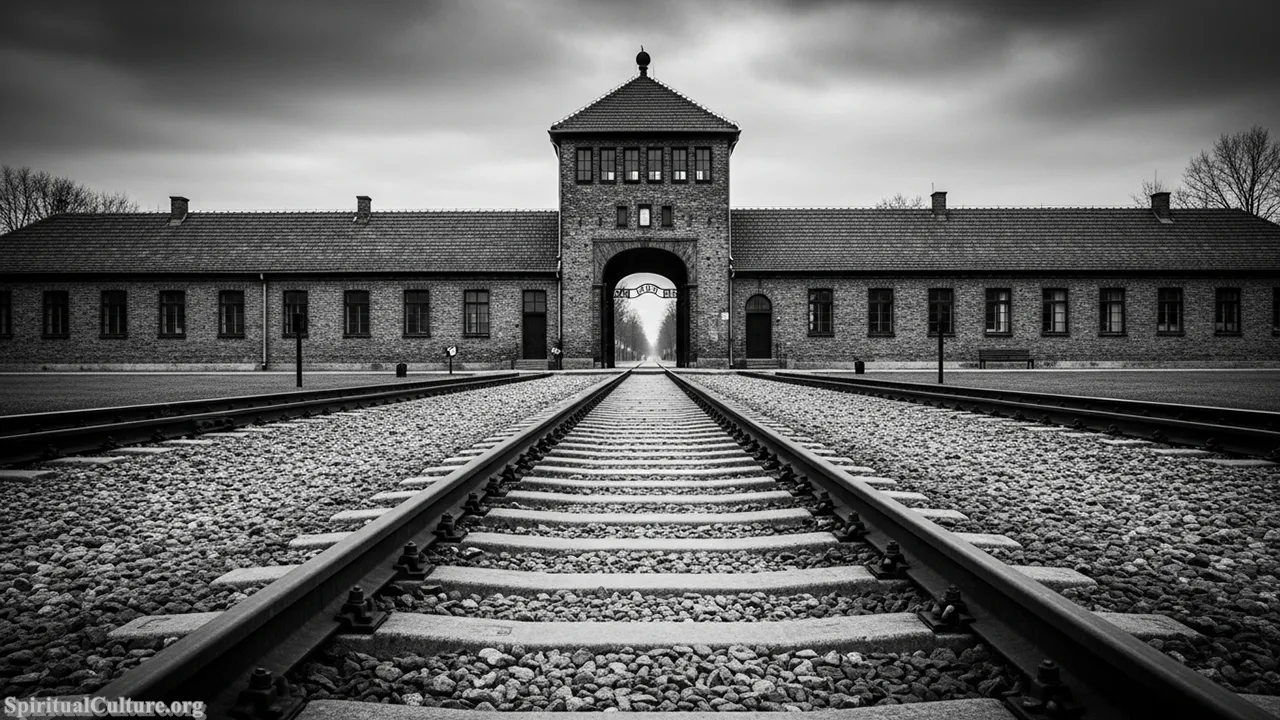
The spiritual impact of this site is devastating yet essential, demanding a confrontation with the ultimate failure of humanity. Its ranking is based on its moral significance as a universal warning and a place of pilgrimage for remembrance, not devotion. It is a sacred space consecrated by suffering, compelling all visitors to meditate on the fragility of human rights, the devastating consequences of hatred, and the spiritual necessity of ‘Never Again.’ It forms a cornerstone of global moral conscience.
The preservation of Auschwitz-Birkenau provides a stark moral lesson: true culture must protect the sanctity of life above all. It serves as an unyielding call to ethical vigilance, reminding us that apathy can lead to atrocity. Its existence is a plea for empathy and an eternal spiritual obligation to honor the victims by advocating for tolerance and human dignity across all cultures and borders.
Cultural/Spiritual Highlights
- The largest extermination camp of Nazi Germany during the Holocaust.
- A UNESCO World Heritage Site inscribed as a ‘symbol of humanity’s dark side.’
- The primary global center for Holocaust remembrance and education.
- The only concentration camp site where preservation focuses on ‘authenticity and integrity.’
Top 7. Assisi, Basilica of San Francesco, Italy
The medieval hill town of Assisi in Umbria, Italy, is the birthplace and final resting place of Saint Francis (born 1182), one of Christianity’s most beloved and influential figures. The Basilica of San Francesco, begun shortly after his death, houses his remains and is famed for its stunning frescoes by masters like Giotto, which narrate the life of the saint and the foundational tenets of his Order.
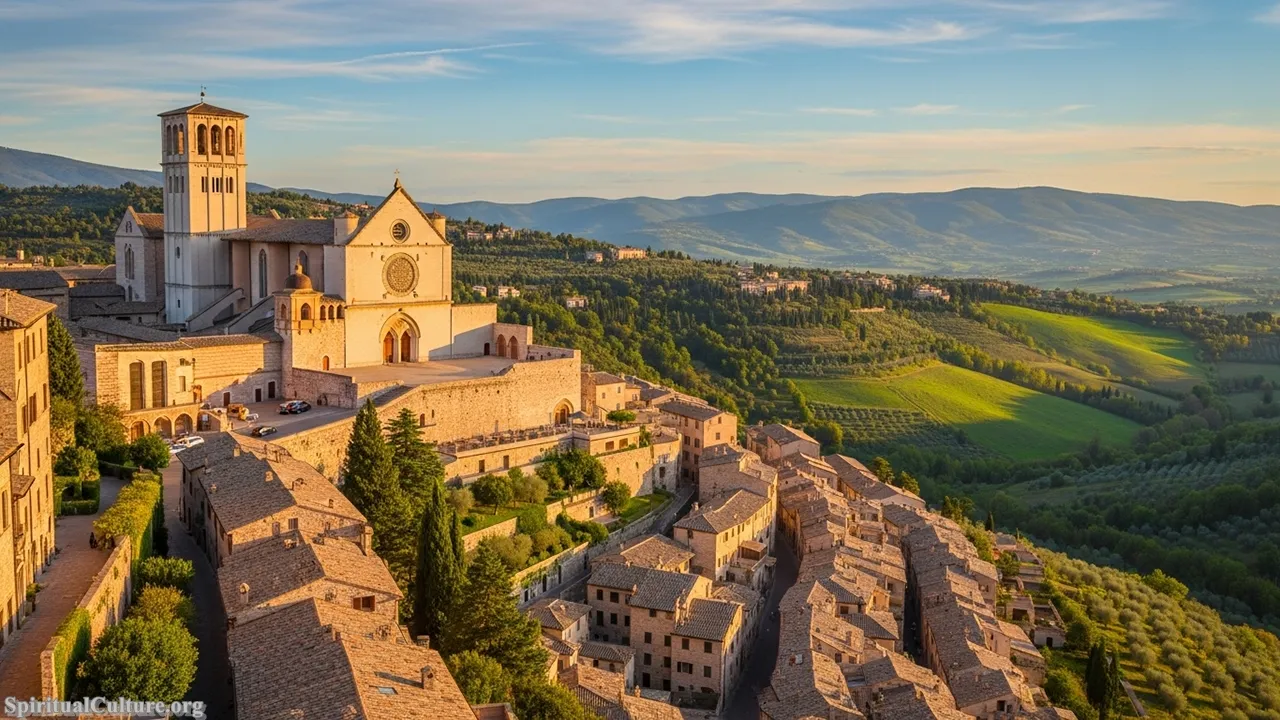
The site’s spiritual impact is rooted in the powerful, revolutionary message of Franciscan spirituality: radical poverty, communion with nature, and selfless service to the poor. The Basilica is not merely an architectural marvel; it is the visual encapsulation of a movement that fundamentally shifted Christian spiritual practice towards simplicity and creation-centered faith. It attracts pilgrims seeking to connect with the humility and compassion St. Francis embodied, offering an alternative spiritual path to medieval ecclesiastical power.
Assisi offers a profound reflection on the moral lesson of divestiture and unity with the natural world, a message critically relevant in the Current Time of Writing. The site embodies the preservation value of a spiritual tradition dedicated to ecological and social justice, urging us to re-examine our relationship with material wealth and to find the divine in every aspect of creation, mirroring the timeless wisdom of St. Francis.
Cultural/Spiritual Highlights
- Center of the Franciscan movement, dedicated to poverty and peace.
- The Basilica features Giotto’s frescoes, marking a pivotal moment in Renaissance art.
- A major Christian pilgrimage site, drawing millions annually.
- Declared a UNESCO World Heritage Site for its unique spiritual and artistic value.
Top 6. The Alhambra, Generalife and Albayzín, Spain
Crowning the city of Granada, the Alhambra is a stunning testament to the Nasrid Dynasty, the last Muslim dynasty to rule in the Iberian Peninsula. Constructed primarily in the 13th and 14th centuries, this palatial city complex—with the Generalife gardens and the adjacent Albayzín quarter—represents the zenith of Moorish art and culture in Europe, surviving the Christian Reconquista to stand as a symbol of cultural cross-pollination.
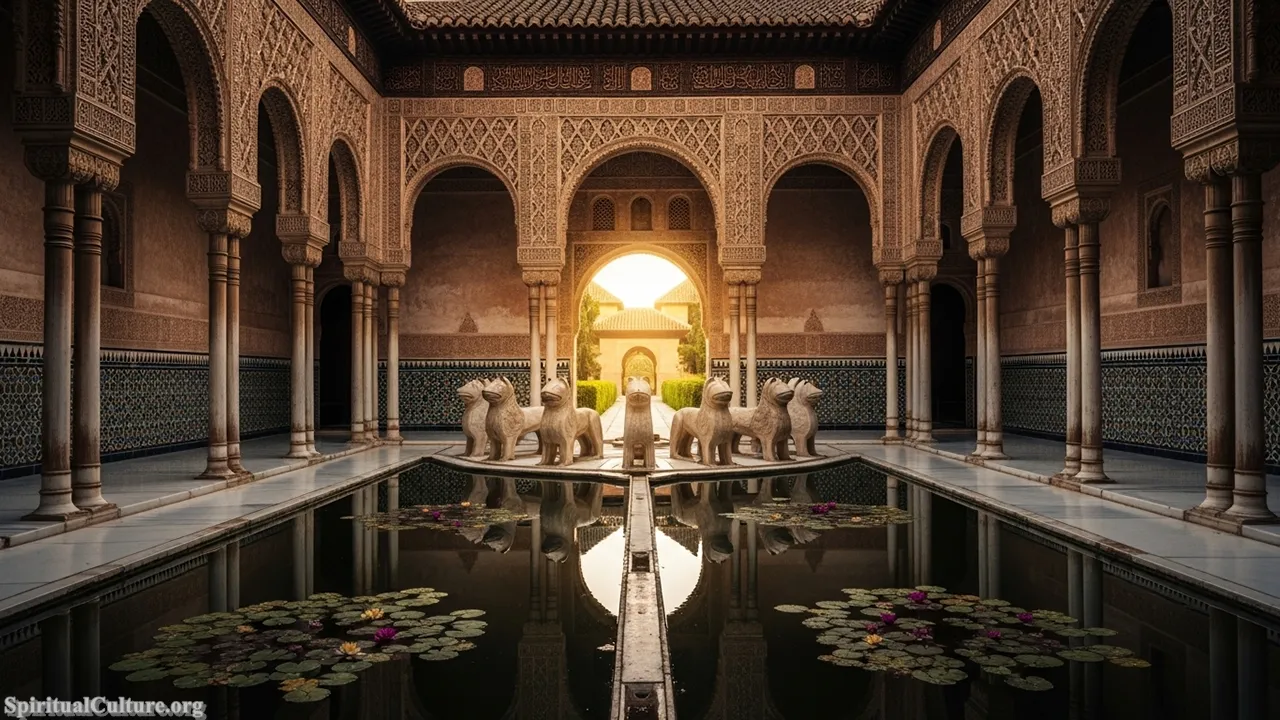
The spiritual impact of the Alhambra lies in its intricate, contemplative architectural design, which is a physical manifestation of Islamic theology. The geometric perfection, the reflective pools, and the pervasive Arabic calligraphy, which quotes the Quran and praises God, transform the palace into a space of sacred beauty. It is a profound spiritual work that celebrates the transcendent through order and detailed craftsmanship, representing the intellectual and spiritual sophistication of Al-Andalus.
The Alhambra’s lasting significance is the preservation of a multicultural golden age. It stands as a vital moral lesson in cultural synthesis, demonstrating how Muslim, Christian, and Jewish traditions coexisted and profoundly enriched European thought, science, and art. At Spiritual Culture, we celebrate it as a memorial to the complexity of European identity and the beauty born of cultural exchange.
Cultural/Spiritual Highlights
- Considered the ultimate masterpiece of Islamic architecture in Europe.
- Features extensive sacred Arabic calligraphy, turning walls into spiritual texts.
- Symbolizes the cultural legacy of Al-Andalus and a period of interfaith complexity.
- Its water systems and gardens (Generalife) embody the Islamic ideal of paradise on Earth.
Top 5. Santiago de Compostela (Pilgrimage Route & Cathedral), Spain
The city of Santiago de Compostela is the traditional burial site of the Apostle Saint James the Great, making it the monumental endpoint of the Camino de Santiago, or “Way of St. James.” This network of pilgrimage routes spans Europe and has drawn pilgrims for over a thousand years, a tradition that remains vibrant in the Current Time of Writing. The Cathedral is a grand synthesis of Romanesque, Gothic, and Baroque styles, built to honor the saint.
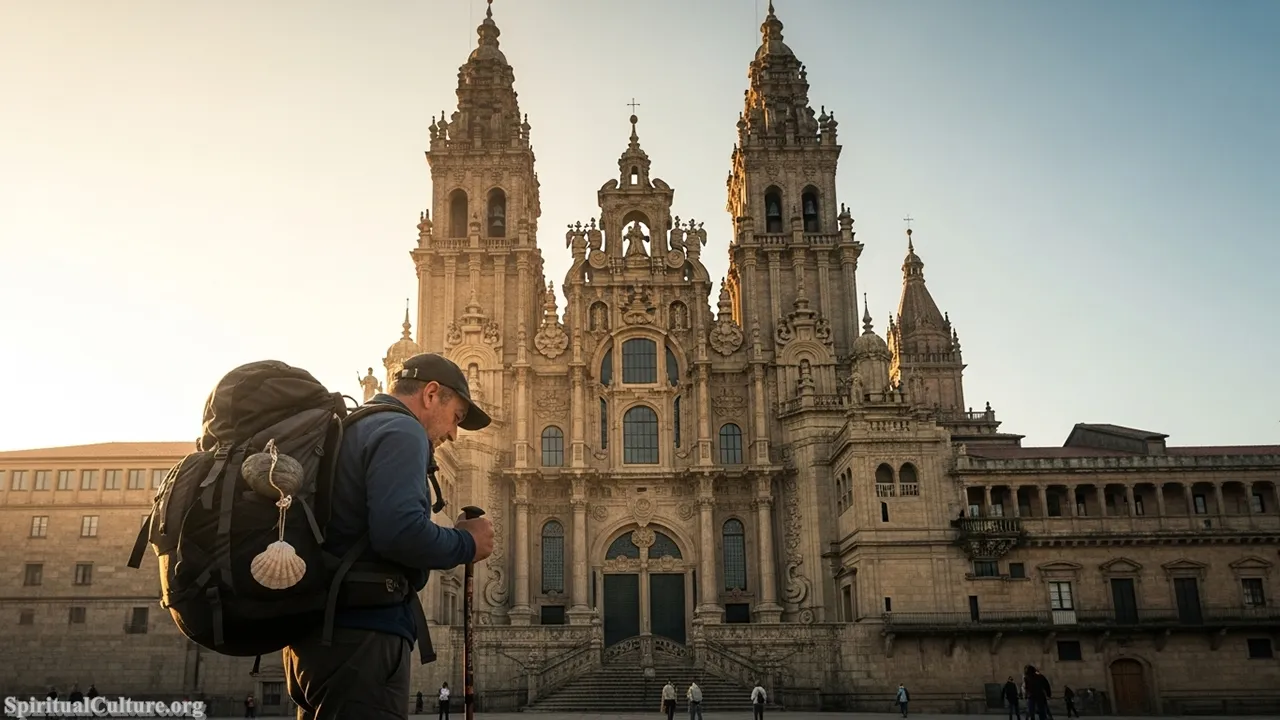
The spiritual impact here is embodied not just in the destination, but in the journey itself. The Camino de Santiago is one of the world’s most important spiritual passages, a physically demanding trek that compels self-reflection, fellowship, and existential inquiry. It has fostered a shared European cultural identity rooted in a collective quest for spiritual renewal, giving the site a profound, ongoing significance as a living testament to faith through action.
The phenomenon of the Camino offers a timeless moral lesson in perseverance, humility, and the transcendent value of community. It serves a crucial preservation role by keeping a medieval tradition alive, demonstrating that true spiritual heritage is not static, but is continuously renewed through the dedication of millions of modern-day pilgrims. It is a powerful reminder that sometimes, the true reward is the path we walk.
Cultural/Spiritual Highlights
- The traditional burial site of the Apostle St. James the Great.
- The Camino de Santiago is a UNESCO-recognized network of living heritage routes.
- The main Cathedral features the Romanesque Pórtico da Gloria, a sculptural masterpiece.
- It annually attracts hundreds of thousands of pilgrims from across the globe.
Top 4. Historic Centre of Rome (Colosseum, Forum, Pantheon)
The Historic Centre of Rome, a UNESCO World Heritage site, encompasses the remnants of the Roman Republic and Empire—a civilization that laid the foundational elements of Western law, language, architecture, and governance. Key monuments like the Colosseum, the Roman Forum, and the Pantheon chart the evolution from a pagan republic to the capital of a vast empire, and later, the seat of the early Christian Church.
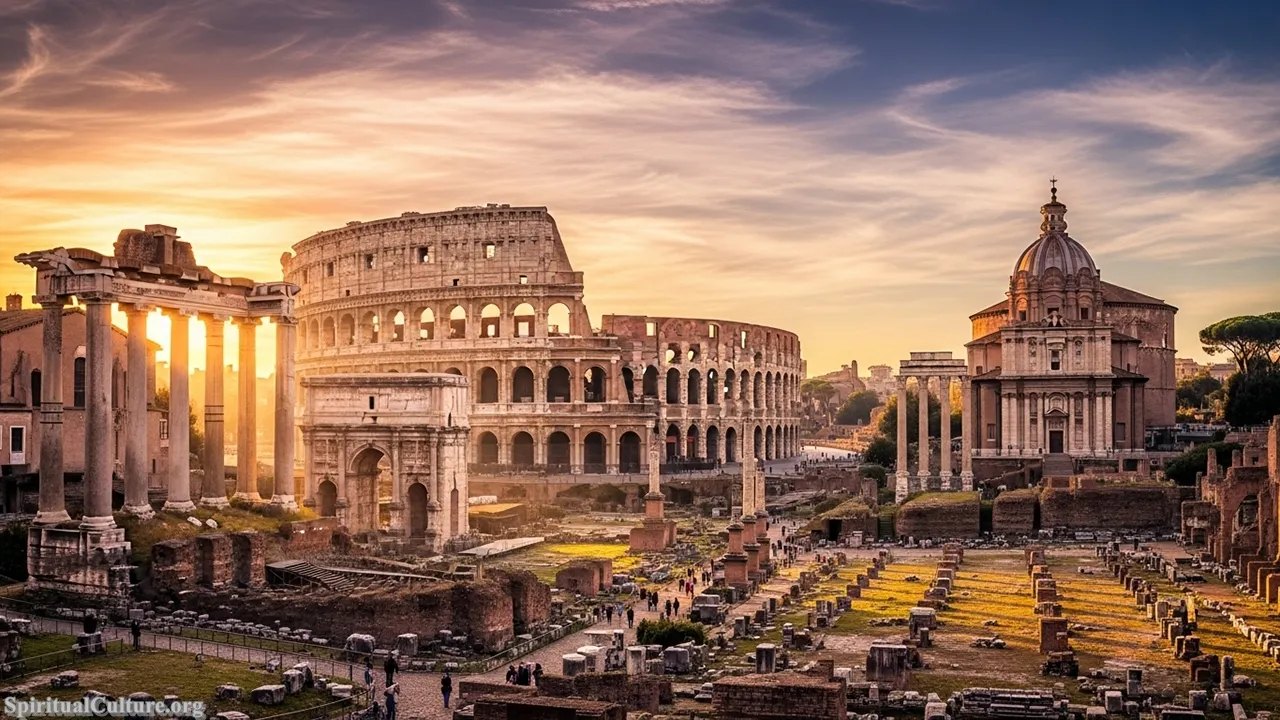
The spiritual impact of this area is two-fold: initially as the axis of a powerful imperial cult that deified emperors and dictated Roman religion, and subsequently as the cradle for the organizational and administrative growth of Catholicism. The transformation of the Pantheon from a temple dedicated to ‘all gods’ to a Christian church, for instance, symbolizes the pivotal, world-altering spiritual shift that occurred in the 4th century, establishing the lasting religious landscape of Europe.
Rome provides a profound lesson in the cyclical nature of power and the endurance of influence. It compels us to consider how ancient infrastructures—political, military, and artistic—can be repurposed for new spiritual ends. The preservation of the Forum and its surrounding monuments acts as a three-dimensional archive, allowing Spiritual Culture visitors to connect the classical roots of their society with the imperial and religious forces that followed.
Cultural/Spiritual Highlights
- The Roman Forum was the political, religious, and economic heart of the Roman Empire.
- The Pantheon remains the best-preserved building of ancient Rome, showcasing architectural genius.
- The Imperial legacy profoundly shaped Western systems of law and political thought.
- The site embodies the transformation of classical paganism into European Christianity.
Top 3. Stonehenge, UK
Stonehenge, located on Salisbury Plain in Wiltshire, UK, is the world’s most iconic prehistoric monument. This ring of standing stones, built in stages from around 3000 BC to 2000 BC, represents the extraordinary intellectual and physical commitment of Neolithic and Bronze Age people. With no written records, its purpose remains an enduring mystery, fueling centuries of speculation ranging from a celestial observatory to a sacred healing or burial site.
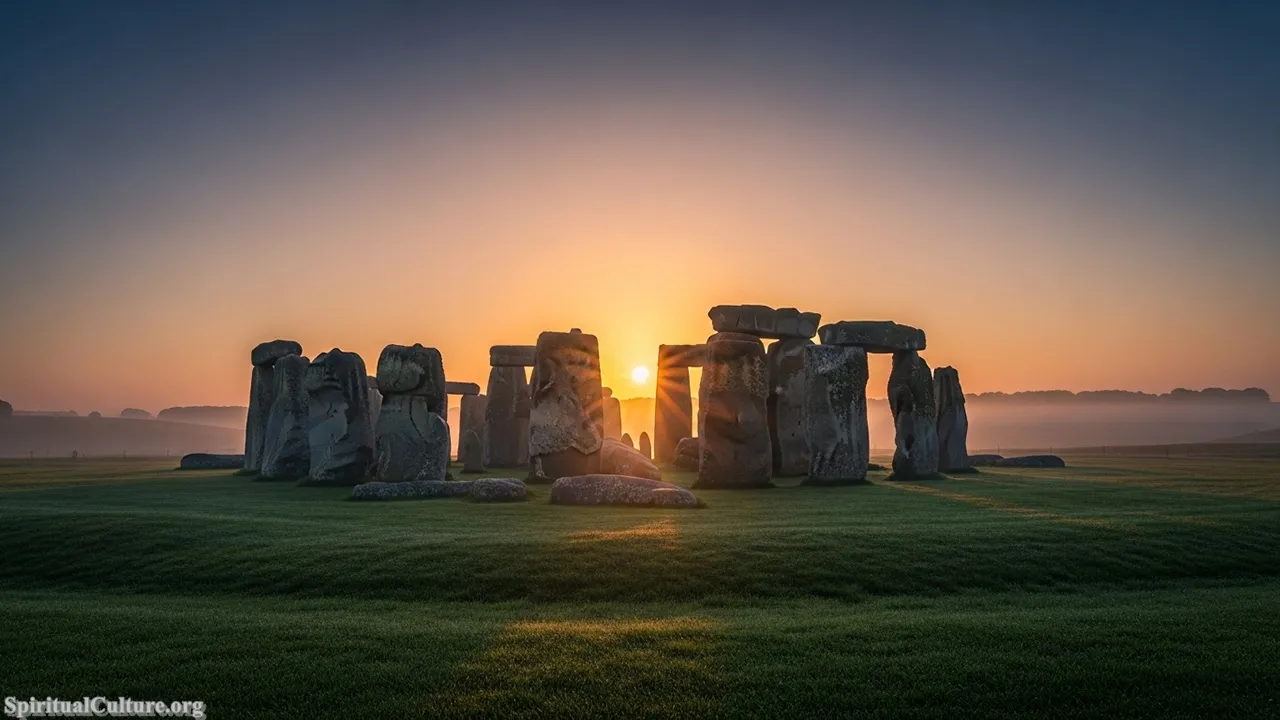
The profound spiritual impact of Stonehenge lies in its role as an ultimate expression of humanity’s connection to cosmic and natural cycles. Its precise alignment with the solstices confirms its function as a ceremonial calendar, anchoring the community’s spiritual life to the rhythm of the sun and seasons. It is a powerful, silent monument to a lost cosmology, compelling modern visitors to contemplate ancient reverence for the earth and the unknown forces of the universe.
Stonehenge teaches a vital lesson about the human spiritual impulse to mark time and sanctify place. Its preservation is crucial not only as an archaeological feat but as a touchstone for contemporary pagan and nature-based spiritualities who continue to use it for ritual. It proves to Spiritual Culture that the oldest heritage, even when its exact meaning is lost, retains the greatest evocative and spiritual power.
Cultural/Spiritual Highlights
- A Neolithic/Bronze Age monument with sophisticated astronomical alignment to the solstices.
- Symbolizes the sophisticated intellectual life and spiritual commitment of prehistoric peoples.
- The subject of numerous myths, including those linking it to the magician Merlin.
- A focal point for modern-day Druidic and Pagan ceremonial gatherings.
Top 2. The Acropolis of Athens (Parthenon), Greece
The Acropolis, towering above Athens, is the definitive symbol of classical antiquity and the birthplace of the democratic ideal. The crowning jewel, the Parthenon, was completed in 438 BC during the Golden Age of Pericles and dedicated to the goddess Athena. This collection of temples and monumental gates is the highest expression of Greek architectural genius and philosophical thought, establishing the standards for Western aesthetics and civilization.
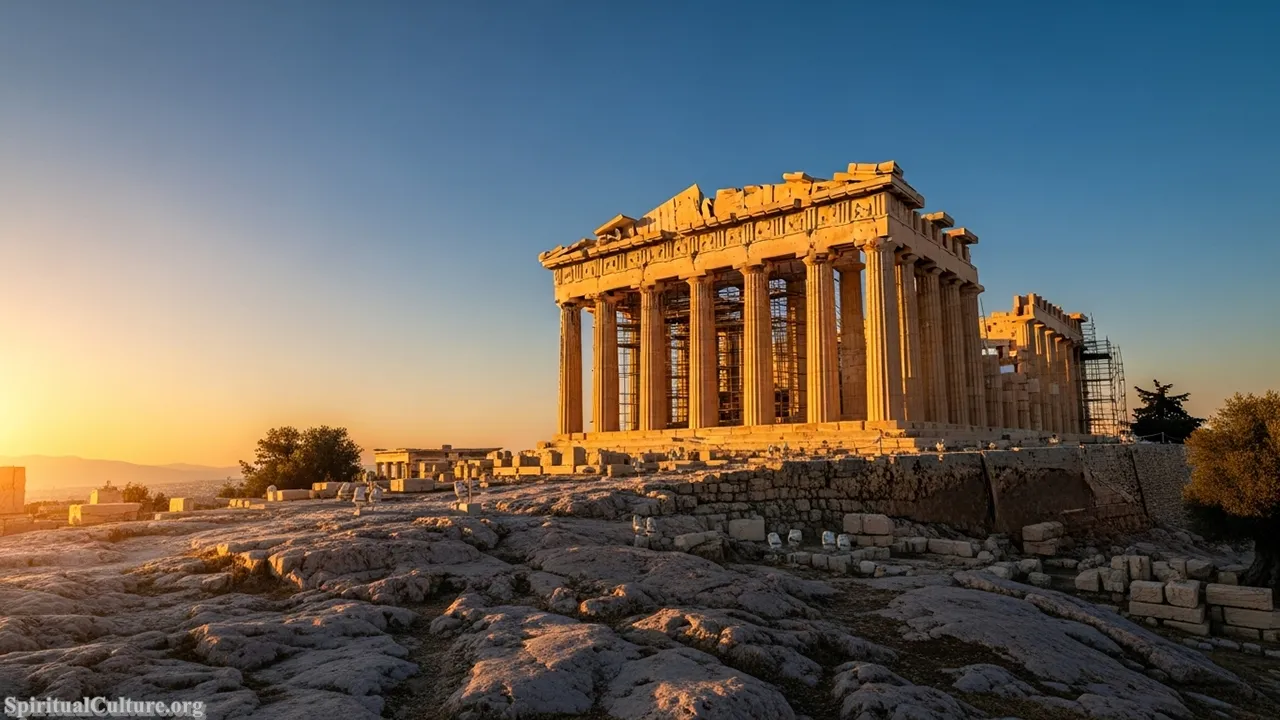
Its spiritual impact is unparalleled, not as a purely religious site but as the foundational locus for Western intellectual and political spirituality. The Acropolis is where the core values of democracy, reasoned inquiry, tragic drama, and philosophy—the pursuit of truth as a spiritual good—were forged. It represents the crucial shift from myth-based tradition to humanistic rationalism, fundamentally shaping the European mind and defining what it means to be a citizen in a free society.
The preservation of the Acropolis today is a global commitment to the moral lesson of human potential and the power of civic ideals. It stands as an eternal symbol of the spirit of critical thinking and self-governance. For Spiritual Culture, this site is a meditation on the beauty of human reason and the sacred duty to defend the philosophical and cultural heritage that birthed the concept of individual freedom and evidence-based inquiry.
Cultural/Spiritual Highlights
- The birthplace of democracy and Western philosophical thought.
- The Parthenon is universally recognized as the pinnacle of Doric order architecture.
- Embodied the Golden Age of Athens under Pericles (5th century BC).
- UNESCO site that influenced neoclassical architecture worldwide for over two millennia.
Top 1. Vatican City (St. Peter’s Basilica & Sistine Chapel), Italy (City-State)
Vatican City, the world’s smallest sovereign state, is the undisputed epicenter of Catholicism, the Christian denomination with the largest global following. It is the spiritual and administrative heart of the Roman Catholic Church, built over the traditional burial site of St. Peter. St. Peter’s Basilica, a Renaissance masterpiece, and the adjacent Sistine Chapel, featuring Michelangelo’s epochal frescoes, house some of the most significant art and relics in human history.
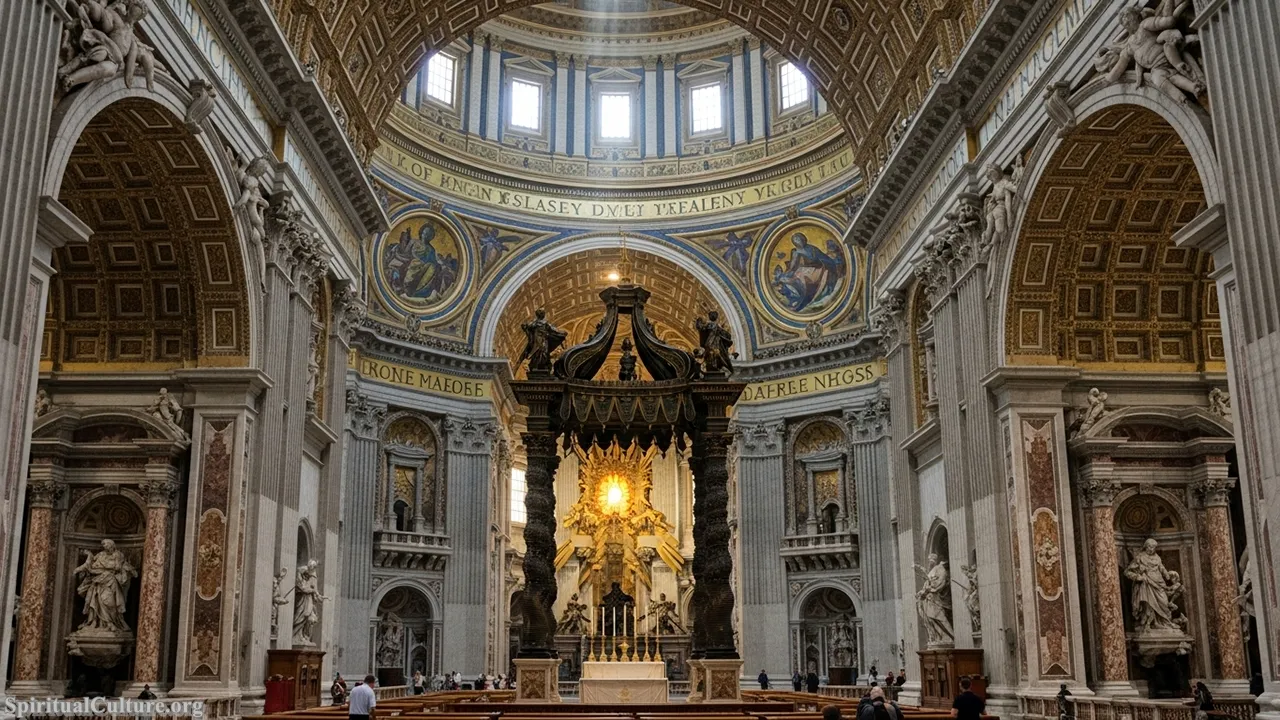
Its spiritual impact is absolute and global, dictating the theological, moral, and cultural life of billions across two millennia. The Vatican is a living, breathing testament to enduring faith, acting as a constant focal point for pilgrimage, governance, and moral authority. Its artistic works, like the Sistine Chapel ceiling, are themselves profound theological statements, turning the space into a unique sanctuary where Renaissance genius merges with the highest spiritual doctrine to define the spiritual landscape of Europe and the world.
The Vatican offers an unparalleled reflection on the fusion of faith, power, and art. The preservation of its contents—from the Basilica to the Apostolic Archives—upholds the continuous narrative of Western civilization’s religious heritage. It compels Spiritual Culture visitors to contemplate the central role of belief systems in shaping historical destiny, standing forever as the foremost symbol of institutionalized spiritual authority and artistic devotion in Europe.
Cultural/Spiritual Highlights
- The administrative and spiritual headquarters of the Roman Catholic Church.
- St. Peter’s Basilica is the world’s largest church and major pilgrimage site.
- The Sistine Chapel frescoes are the definitive visual statements of Christian theology.
- Sovereign city-state that preserves millennia of historical and religious documents.
Conclusion
The historical sites of Europe are more than just ruins or monuments; they are the concentrated essence of global human endeavor. From the silent, cosmic geometry of Stonehenge to the thundering moral authority emanating from the Vatican and the Acropolis, each site in this Top 10 list represents a pivot point—a moment where culture, faith, and political philosophy profoundly changed course. At Spiritual Culture, we celebrate these locations not just for their past glory, but for their continued power to inspire reflection, demand moral consciousness, and sustain the threads of humanistic heritage in our modern world.
To walk through these spaces is to engage in a profound spiritual archaeology, recognizing that the roots of our contemporary society are deeply embedded in the sacred grounds of the past. May these enduring symbols continue to guide us toward a future that honors the wisdom, artistry, and ethical lessons bequeathed by our forebears. They are Europe’s gift to the enduring human spirit.

